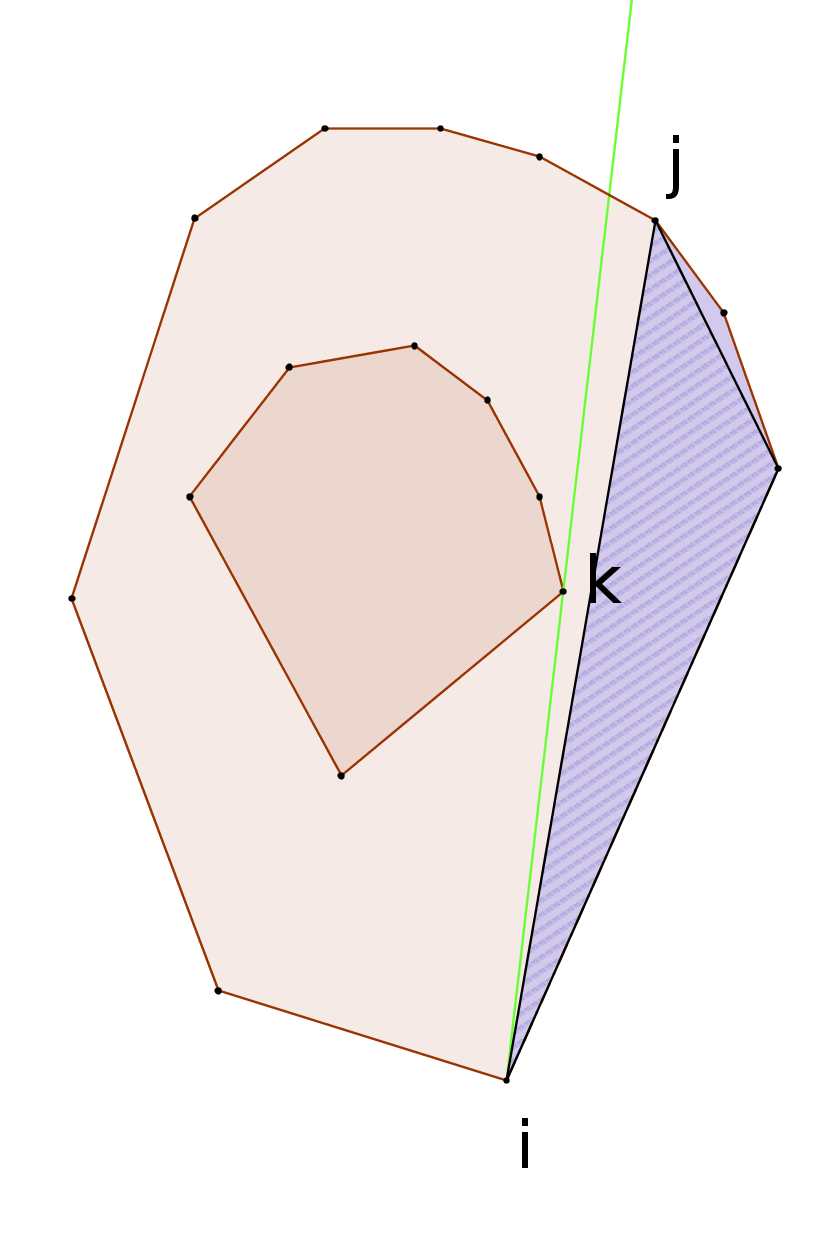Remember to use this editorial only when stuck, and not to copy-paste code from it. Please be respectful to the problem author and editorialist.
Submitting an official solution before solving the problem yourself is a bannable offence.
To begin with, let's assume that in the interior of the polygon there are more than two points and not all of them are on the same line. We are only interested in the points on the convex hull from the inner set. For a polygon vertex  we have the situation as depicted:
we have the situation as depicted:
The green color marks the tangent in ccw (counter-clockwise) direction to the inner hull, index  marks the belonging hull vertex, and index
marks the belonging hull vertex, and index  marks the polygon vertex to which (in ccw direction) we can make the best cut from
marks the polygon vertex to which (in ccw direction) we can make the best cut from  . Notice that this will always be the last vertex (starting from
. Notice that this will always be the last vertex (starting from  ) from the right side of the tangent (looking from
) from the right side of the tangent (looking from  facing
facing  ). The area of the polygon from vertex
). The area of the polygon from vertex  to
to  is marked with purple and let's assume it's
is marked with purple and let's assume it's  . If we take the maximum of these areas for each
. If we take the maximum of these areas for each  (vertex
(vertex  is determined with vertex
is determined with vertex  ), we will get the solution.
), we will get the solution.
Let's denote with  the vertex adjacent to vertex
the vertex adjacent to vertex  in ccw direction. We are interested in vertex
in ccw direction. We are interested in vertex  of the inner hull through which the tangent from
of the inner hull through which the tangent from  is going to pass, and vertex
is going to pass, and vertex  , the optimal vertex for
, the optimal vertex for  . Let's observe the following image:
. Let's observe the following image:
Vertex  can be found so that we move in ccw direction on the inner hull as long as the next vertex is on the right side of the line from
can be found so that we move in ccw direction on the inner hull as long as the next vertex is on the right side of the line from  to the current vertex (if we're looking from
to the current vertex (if we're looking from  facing the current vertex). In the image, the vertices for which the next vertex is better are marked with red.
facing the current vertex). In the image, the vertices for which the next vertex is better are marked with red.
We can find vertex  so that we move in ccw direction on the polygon as long as the next vertex is on the right side of the line
so that we move in ccw direction on the polygon as long as the next vertex is on the right side of the line  , from
, from  facing
facing  .
.
Notice that in this procedure we can keep track of the current area. When we move from  to
to  , we subtract the area of the triangle
, we subtract the area of the triangle  (marked in the first image). When we look at index
(marked in the first image). When we look at index  , we add the area of the corresponding triangle in each move (those triangles are separated using dotted lines in the second image).
, we add the area of the corresponding triangle in each move (those triangles are separated using dotted lines in the second image).
The complexity of finding the convex hull of an inner set of points is  . After that, finding the optimal cut is
. After that, finding the optimal cut is  , where
, where  is the number of points on the hull, or
is the number of points on the hull, or  in the worst case scenario. Index
in the worst case scenario. Index  will go through all the points of the outer polygon. Finding the indices
will go through all the points of the outer polygon. Finding the indices  and
and  can be complex in one transition, but in total it's amortised because both indices can visit a point at most once (
can be complex in one transition, but in total it's amortised because both indices can visit a point at most once ( on the polygon,
on the polygon,  on the inner hull).
on the inner hull).


Comments